法国新阿基坦地区农业用地GIS多威胁模型。支持有针对性政策的综合指标方法
IF 5.9
1区 社会学
Q1 ENVIRONMENTAL STUDIES
引用次数: 0
摘要
粮食主权再次成为全球和地方的优先事项。然而,有用的农业面积继续减少。土地征用正导致对农田的压力越来越大,而农田正受到不同现象的威胁——比如自然风险和人口动态。因此,农田受到许多不同因素的威胁。需要采用多标准方法来考虑许多因素及其相互作用。然而,当涉及到理解农业用地压力问题时,对多威胁方法的科学理解仍然有限。因此,本研究基于土地占用、能源竞争力、自然和人为危害、人口减少4个综合指标,采用多准则评价流程,构建农业用地威胁多准则模型。这些指标综合在一个全球农业用地压力多准则模型中。研究区域是新阿基坦大区,这是法国最大的大区,拥有9个功能城区和1,597,720个农业地块(39,458.2平方公里)。本研究完全基于INSPIRE指令下的开放数据,使用地理信息系统(ArcGIS Pro)。结果显示,有242525个样地(占农业面积的14.93 %)受到高度威胁,380202个样地(占农业面积的20.75 %)受到高度威胁。土地掠夺和自然灾害肯定会影响威胁等级。研究表明,受到威胁的地块往往比不那么受威胁的地块要小。研究结果可以帮助地方当局制定有针对性的战略,以维持该地区的农业用地和生产能力。这种贡献是可扩展和可复制到其他区域和国家的。本文章由计算机程序翻译,如有差异,请以英文原文为准。
GIS multi-threat models for agricultural land in the Nouvelle-Aquitaine region (France). A methodology of composite indicators to support targeted policies
Food sovereignty is yet again a global and local priority. Nevertheless, the useful agricultural area continues to decrease. Land take is leading to increasing pressure on farmland, which is threatened by different phenomena –such as natural risks and demographic dynamics–. Farmland is therefore threatened by a number of different factors. A multi-criteria approach is needed to consider many factors and their interactions. Nevertheless, scientific understanding of the multi-threat approach is still limited when it comes to understanding the issue of agricultural land pressure. Thus, this research implements a multi-criteria evaluation workflow to develop multi-criteria models of land threat on agricultural land based on four composite indicators: land take, energy competitiveness, natural and anthropogenic hazards, and demographic decline. These indicators are synthetized in a global multi-criteria model of agricultural land pressure. The study area is the Nouvelle-Aquitaine Region, the largest French region with 9 functional urban areas and 1,597,720 agricultural plots (39,458.2 sq.km). This research is entirely based on open data according to the INSPIRE Directive, using Geographic Information Systems (ArcGIS Pro). Results show high threat level in 242,525 plots (14.93 % of agricultural area) and very high levels in 380,202 plots (20.75 % of agricultural area). Land take and natural hazards definitively contribute to the threat level. The study reveals that plots under threat tend to be smaller than less threatened ones. Results can help local authorities develop targeted strategies to maintain the region's agricultural land and productive capacity. This contribution is scalable and replicable to other regions and countries.
求助全文
通过发布文献求助,成功后即可免费获取论文全文。
去求助
来源期刊

Land Use Policy
ENVIRONMENTAL STUDIES-
CiteScore
13.70
自引率
8.50%
发文量
553
期刊介绍:
Land Use Policy is an international and interdisciplinary journal concerned with the social, economic, political, legal, physical and planning aspects of urban and rural land use.
Land Use Policy examines issues in geography, agriculture, forestry, irrigation, environmental conservation, housing, urban development and transport in both developed and developing countries through major refereed articles and shorter viewpoint pieces.
 求助内容:
求助内容: 应助结果提醒方式:
应助结果提醒方式:


